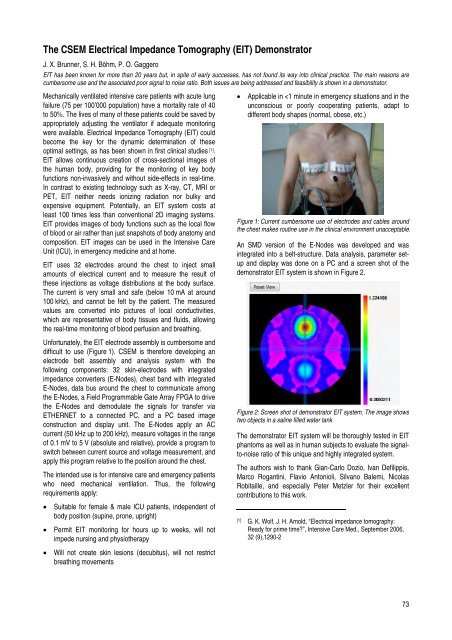CSEM Scientific and Technical Report 2008
CSEM Scientific and Technical Report 2008
CSEM Scientific and Technical Report 2008
You also want an ePaper? Increase the reach of your titles
YUMPU automatically turns print PDFs into web optimized ePapers that Google loves.
The <strong>CSEM</strong> Electrical Impedance Tomography (EIT) Demonstrator<br />
J. X. Brunner, S. H. Böhm, P. O. Gaggero<br />
EIT has been known for more than 20 years but, in spite of early successes, has not found its way into clinical practice. The main reasons are<br />
cumbersome use <strong>and</strong> the associated poor signal to noise ratio. Both issues are being addressed <strong>and</strong> feasibility is shown in a demonstrator.<br />
Mechanically ventilated intensive care patients with acute lung<br />
failure (75 per 100’000 population) have a mortality rate of 40<br />
to 50%. The lives of many of these patients could be saved by<br />
appropriately adjusting the ventilator if adequate monitoring<br />
were available. Electrical Impedance Tomography (EIT) could<br />
become the key for the dynamic determination of these<br />
optimal settings, as has been shown in first clinical studies [1] .<br />
EIT allows continuous creation of cross-sectional images of<br />
the human body, providing for the monitoring of key body<br />
functions non-invasively <strong>and</strong> without side-effects in real-time.<br />
In contrast to existing technology such as X-ray, CT, MRI or<br />
PET, EIT neither needs ionizing radiation nor bulky <strong>and</strong><br />
expensive equipment. Potentially, an EIT system costs at<br />
least 100 times less than conventional 2D imaging systems.<br />
EIT provides images of body functions such as the local flow<br />
of blood or air rather than just snapshots of body anatomy <strong>and</strong><br />
composition. EIT images can be used in the Intensive Care<br />
Unit (ICU), in emergency medicine <strong>and</strong> at home.<br />
EIT uses 32 electrodes around the chest to inject small<br />
amounts of electrical current <strong>and</strong> to measure the result of<br />
these injections as voltage distributions at the body surface.<br />
The current is very small <strong>and</strong> safe (below 10 mA at around<br />
100 kHz), <strong>and</strong> cannot be felt by the patient. The measured<br />
values are converted into pictures of local conductivities,<br />
which are representative of body tissues <strong>and</strong> fluids, allowing<br />
the real-time monitoring of blood perfusion <strong>and</strong> breathing.<br />
Unfortunately, the EIT electrode assembly is cumbersome <strong>and</strong><br />
difficult to use (Figure 1). <strong>CSEM</strong> is therefore developing an<br />
electrode belt assembly <strong>and</strong> analysis system with the<br />
following components: 32 skin-electrodes with integrated<br />
impedance converters (E-Nodes), chest b<strong>and</strong> with integrated<br />
E-Nodes, data bus around the chest to communicate among<br />
the E-Nodes, a Field Programmable Gate Array FPGA to drive<br />
the E-Nodes <strong>and</strong> demodulate the signals for transfer via<br />
ETHERNET to a connected PC, <strong>and</strong> a PC based image<br />
construction <strong>and</strong> display unit. The E-Nodes apply an AC<br />
current (50 kHz up to 200 kHz), measure voltages in the range<br />
of 0.1 mV to 5 V (absolute <strong>and</strong> relative), provide a program to<br />
switch between current source <strong>and</strong> voltage measurement, <strong>and</strong><br />
apply this program relative to the position around the chest.<br />
The intended use is for intensive care <strong>and</strong> emergency patients<br />
who need mechanical ventilation. Thus, the following<br />
requirements apply:<br />
• Suitable for female & male ICU patients, independent of<br />
body position (supine, prone, upright)<br />
• Permit EIT monitoring for hours up to weeks, will not<br />
impede nursing <strong>and</strong> physiotherapy<br />
• Will not create skin lesions (decubitus), will not restrict<br />
breathing movements<br />
• Applicable in








